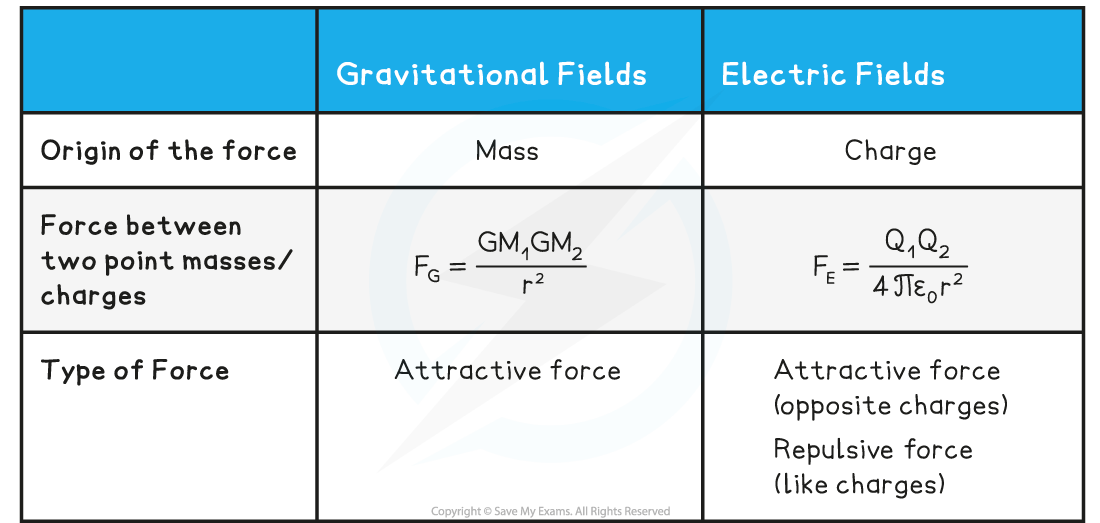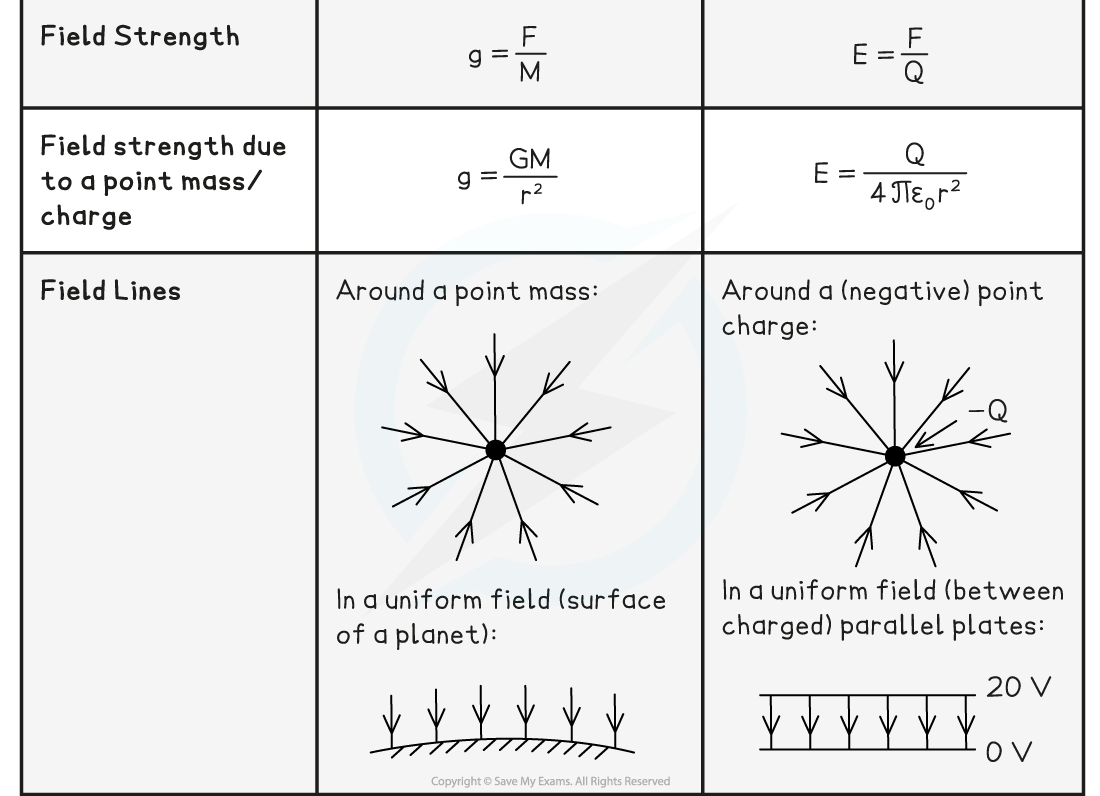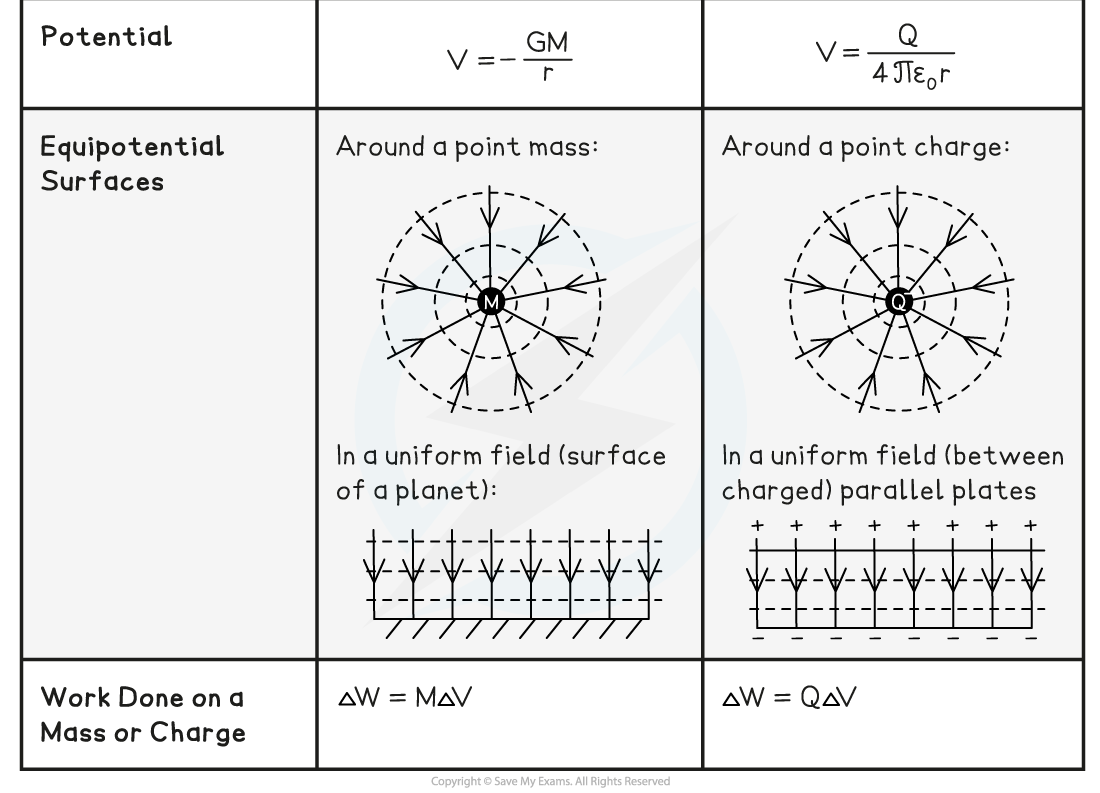Gravitational & Electrostatic Fields
- A field can be defined as
A region in which an object will experience a force, such as gravitational or electrostatic, at a distance
- A gravitational field can be defined as:
The gravitational force per unit mass exerted on a point mass
- An electrostatic field can be defined as:
The electric force per unit charge exerted on a small positive test charge
- Fields can be described in terms of field strength, which is defined as:
- Electric field strength, E, and gravitational field strength, g, therefore, have very similar equations
- Despite a few differences, they are analogous to one another in many ways
- In both cases, the nature of the test object is as follows:
- Gravitational fields: small mass, m
- Electrostatic fields: small positive charge, q
Uniform Fields
- A gravitational field is a region of space in which objects with mass will experience a force
- The gravitational field strength can be calculated using the equation:
- Where:
- g = gravitational field strength (N kg-1)
- F = gravitational force on the mass (N)
- m = mass (kg)
- The direction of the gravitational field is always directed towards the centre of the mass
- Gravitational forces are always attractive and cannot be repulsive
- An electric field is a region of space in which an electric charge will experience a force
- The electric field strength can be calculated using the equation:
- Where:
- E = electric field strength (N C-1)
- F = electrostatic force on the charge (N)
- Q = Charge (C)
- It is important to use a positive test charge in this definition, as this determines the direction of the electric field
- The electric field strength is a vector quantity, it is always directed:
- Away from a positive charge
- Towards a negative charge
- Opposite charges (positive and negative) attract each other
- Conversely, like charges (positive-positive or negative-negative) repel each other
- The magnitude of the electric field strength in a uniform field between two charged parallel plates is defined as:
- Where:
- E = electric field strength (V m-1)
- V = potential difference between the plates (V)
- d = separation between the plates (m)
- The electric field strength is now defined by the units V m–1
- Therefore, the units V m–1 are equivalent to the units N C–1
- The equation shows:
- The greater the voltage (potential difference) between the plates, the stronger the field
- The greater the separation between the plates, the weaker the field
- This equation cannot be used to find the electric field strength around a point charge (since this would be a radial field)
- The direction of the electric field is from the plate connected to the positive terminal of the cell to the plate connected to the negative terminal

The E field strength between two charged parallel plates is the ratio of the potential difference and separation of the plates
- Note: if one of the parallel plates is earthed, it has a voltage of 0 V
Radial Fields
- A point charge or mass produces a radial field
- A charged sphere also acts as a point charge
- A spherical mass also acts as a point mass
- Radial fields always have an inverse square law relationship with distance
- This means the field strength decreases by a factor of four when the distance r is doubled
- The gravitational force FG between two masses is defined by:
- Where:
- FG = gravitational force between two masses (N)
- G = Newton’s gravitational constant
- m1, m2 = two points masses (kg)
- r = distance between the centre of the two masses (m)
- The electric field strength E at a distance r due to a point charge Q in free space is defined by:
- Where:
- Q = the point charge producing the radial electric field (C)
- r = distance from the centre of the charge (m)
- ε0 = permittivity of free space (F m-1) = (
)
- This equation shows:
- The electric field strength in a radial field is not constant
- As the distance, r, from the charge increases, E decreases by a factor of 1/r2
Gravitational vs Electrostatic Forces
- The similarities and differences between gravitational and electrostatic forces are listed in the table below:
Comparing G and E Fields



- The key similarities are:
- The magnitude of the gravitational and electrostatic force between two point masses or charges are inverse square law relationships
- The field lines around a point mass and negative point charge are identical
- The field lines in a uniform gravitational and electric field are identical
- The gravitational field strength and electric field strength both have a 1 / r2 relationship in a radial field
- The gravitational potential and electric potential both have a 1 / r relationship
- Equipotential surfaces for both gravitational and electric fields are spherical around a point mass or charge and equally spaced parallel lines in uniform fields
- The work done in each field is either the product of the mass and change in potential or charge and change in potential
- The key differences are:
- The gravitational force acts on particles with mass whilst the electrostatic force acts on particles with charge
- The gravitational force is always attractive whilst the electrostatic force can be attractive or repulsive
- The gravitational potential is always negative whilst the electric potential can be either negative or positive
Worked Example
Two parallel metal plates are separated by 3.5 cm and have a potential difference of 7.9 kV.
Calculate the electric force acting on a stationary charged particle between the plates that has a charge of 2.6 × 10-15 C.
Step 1: Write down the known values
-
- Potential difference, V = 7.9 kV = 7.9 × 103 V
- Distance between plates, d = 3.5 cm = 3.5 × 10-2 m
- Charge, Q = 2.6 × 10-15 C
Step 2: Calculate the electric field strength between the parallel plates
Step 3: Write out the equation for electric force on a charged particle
Step 4: Substitute electric field strength and charge into electric force equation
Exam Tip
Remember to use the correct equation depending on whether there is a uniform or radial field.
For electric fields:
- Uniform fields: parallel plates / capacitors
- Radial fields: around point charges
For gravitational fields:
- Uniform fields: near the Earth's surface
- Radial fields: around masses (e.g. planets and moons)
You should be able to tell the type of field from the field lines. Uniform fields have equally spaced, parallel field lines.
